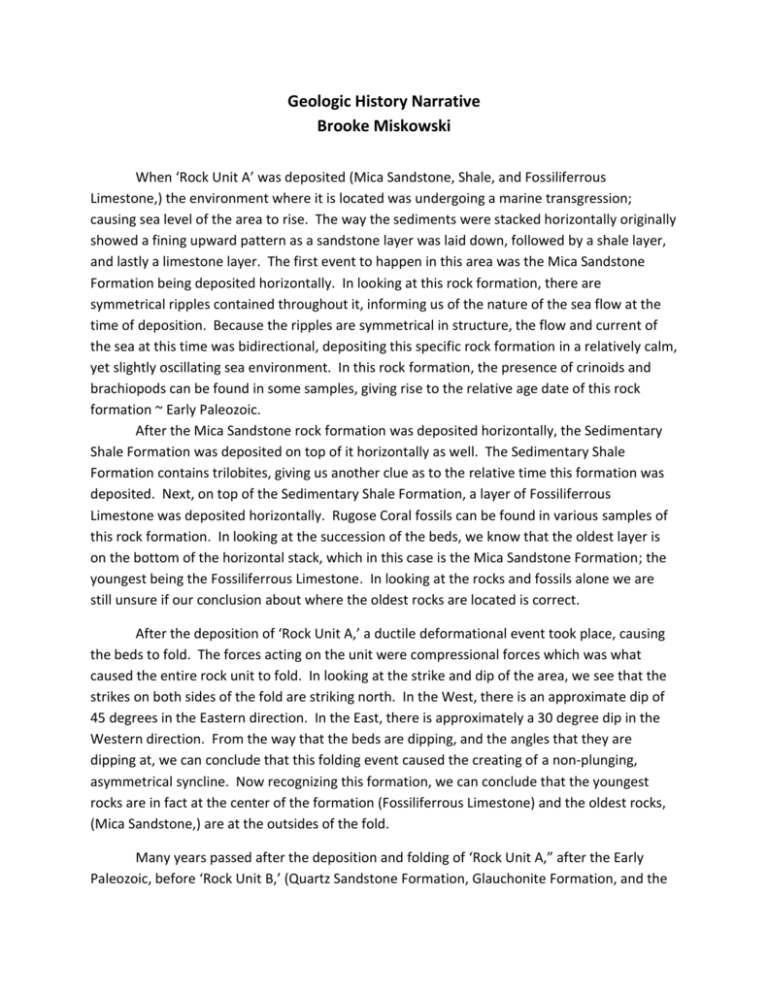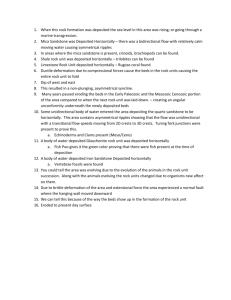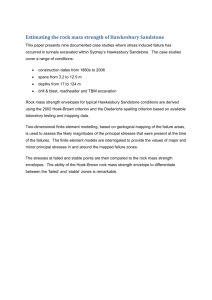Geology Narrative
advertisement

Geologic History Narrative Brooke Miskowski When ‘Rock Unit A’ was deposited (Mica Sandstone, Shale, and Fossiliferrous Limestone,) the environment where it is located was undergoing a marine transgression; causing sea level of the area to rise. The way the sediments were stacked horizontally originally showed a fining upward pattern as a sandstone layer was laid down, followed by a shale layer, and lastly a limestone layer. The first event to happen in this area was the Mica Sandstone Formation being deposited horizontally. In looking at this rock formation, there are symmetrical ripples contained throughout it, informing us of the nature of the sea flow at the time of deposition. Because the ripples are symmetrical in structure, the flow and current of the sea at this time was bidirectional, depositing this specific rock formation in a relatively calm, yet slightly oscillating sea environment. In this rock formation, the presence of crinoids and brachiopods can be found in some samples, giving rise to the relative age date of this rock formation ~ Early Paleozoic. After the Mica Sandstone rock formation was deposited horizontally, the Sedimentary Shale Formation was deposited on top of it horizontally as well. The Sedimentary Shale Formation contains trilobites, giving us another clue as to the relative time this formation was deposited. Next, on top of the Sedimentary Shale Formation, a layer of Fossiliferrous Limestone was deposited horizontally. Rugose Coral fossils can be found in various samples of this rock formation. In looking at the succession of the beds, we know that the oldest layer is on the bottom of the horizontal stack, which in this case is the Mica Sandstone Formation; the youngest being the Fossiliferrous Limestone. In looking at the rocks and fossils alone we are still unsure if our conclusion about where the oldest rocks are located is correct. After the deposition of ‘Rock Unit A,’ a ductile deformational event took place, causing the beds to fold. The forces acting on the unit were compressional forces which was what caused the entire rock unit to fold. In looking at the strike and dip of the area, we see that the strikes on both sides of the fold are striking north. In the West, there is an approximate dip of 45 degrees in the Eastern direction. In the East, there is approximately a 30 degree dip in the Western direction. From the way that the beds are dipping, and the angles that they are dipping at, we can conclude that this folding event caused the creating of a non-plunging, asymmetrical syncline. Now recognizing this formation, we can conclude that the youngest rocks are in fact at the center of the formation (Fossiliferrous Limestone) and the oldest rocks, (Mica Sandstone,) are at the outsides of the fold. Many years passed after the deposition and folding of ‘Rock Unit A,” after the Early Paleozoic, before ‘Rock Unit B,’ (Quartz Sandstone Formation, Glauchonite Formation, and the Iron Rich Sandstone Formation) came to be deposited. In looking at the non-recorded time, we can tell that there is an unconformity present between ‘Rock Unit A’ and ‘Rock Unit B,’ more specifically an angular unconformity is created underneath the newly deposited rocks. In analyzing the fossil types in ‘Rock Unit B,’ (Echinoderms, clams, the presence of fish, and bone fragments,) we can conclude that this unit was deposited sometime during the Mesozoic – Cenozoic time period. The first thing that happened in this rock unit is that that some unidirectional body of water entered the area, depositing the Quartz Sandstone Formation horizontally. We know that this formation was deposited in a unidirectional flow environment due to the presence of asymmetric ripples in this specific rock type. The ripples contained some tuning fork junctions (transitioning from 2D to 3D ripples,) suggesting that the flow speed of the water in the area at the time of deposition was moderate to fast (transitional) as the 2D crests were becoming for 3D structurally. Echinoderms and Clams can also be found in the Quartz Sandstone Formation, again suggesting that this rock formation was laid down sometime during the Mesozoic – Cenozoic. After the deposition of the Quartz sandstone, some body of water deposited the Glauchonite Rock Formation Horizontally. The presence of fish poo in this rock type tells us that fish were present during the time of the deposition. After this body of water deposited the Glauchonite Formation, another Formation (Iron Rich Sandstone,) was deposited on top of it horizontally. Vertebrae fossils were found in this rock formation, suggesting the presence of larger animals. In analyzing the fossil progression, from echinoderms and clams, to fish and eventually Vertebrae we can conclude that the Quartz Sandstone Formation is the oldest of ‘Rock Unit B,’ followed by the Glauchonite Formation, with the youngest being the Iron Rich Sandstone. As the animals and organisms present in the area were evolving, the different rock unit composition changed over time as well due to the fact that the animals were changing the environment they lived in. (For example, the sandstone over time started to contain fish poo, and eventually an iron impurity suggesting the abundance of oxygen.) After these rock formations were laid down horizontally, an event causing brittle deformation occurred in the area. An extensional force was pulling the area apart, resulting in a normal faulting of ‘Rock Unit B.” In this area we know it was a normal fault because the hanging wall moved down with respect to the footwall. The rocks originally were stacked horizontally with the Iron Rich Sandstone Formation on the bottom, followed by the Glauchonite Formation on top of that, and the youngest on top; the Quartz Sandstone. When the fault happened, the other rock unit was moved downward. We can tell this because of the way the beds show up on the formation after they are eroded to the present day surface; which is the last event to happen.






